#Philadelphia College of Textile and Science
Explore tagged Tumblr posts
Text

Aleksandra Kasuba studio space at the Philadelphia College of Textile and Science (1977)
#Aleksandra Kasuba#Philadelphia College of Textile and Science#textile#science#green#art#studio#1977
3K notes
·
View notes
Text
NASA Inspires Your Crafty Creations for World Embroidery Day
It’s amazing what you can do with a little needle and thread! For #WorldEmbroideryDay, we asked what NASA imagery inspired you. You responded with a variety of embroidered creations, highlighting our different areas of study.
Here’s what we found:
Webb’s Carina Nebula
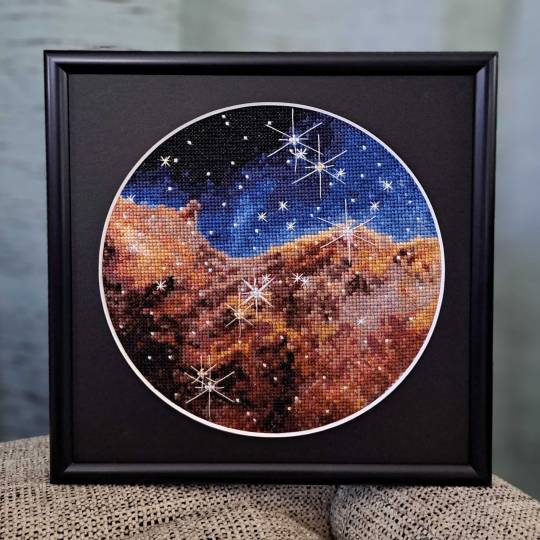
Wendy Edwards, a project coordinator with Earth Science Data Systems at NASA, created this embroidered piece inspired by Webb’s Carina Nebula image. Captured in infrared light, this image revealed for the first time previously invisible areas of star birth. Credit: Wendy Edwards, NASA. Pattern credit: Clare Bray, Climbing Goat Designs
Wendy Edwards, a project coordinator with Earth Science Data Systems at NASA, first learned cross stitch in middle school where she had to pick rotating electives and cross stitch/embroidery was one of the options. “When I look up to the stars and think about how incredibly, incomprehensibly big it is out there in the universe, I’m reminded that the universe isn’t ‘out there’ at all. We’re in it,” she said. Her latest piece focused on Webb’s image release of the Carina Nebula. The image showcased the telescope’s ability to peer through cosmic dust, shedding new light on how stars form.
Ocean Color Imagery: Exploring the North Caspian Sea
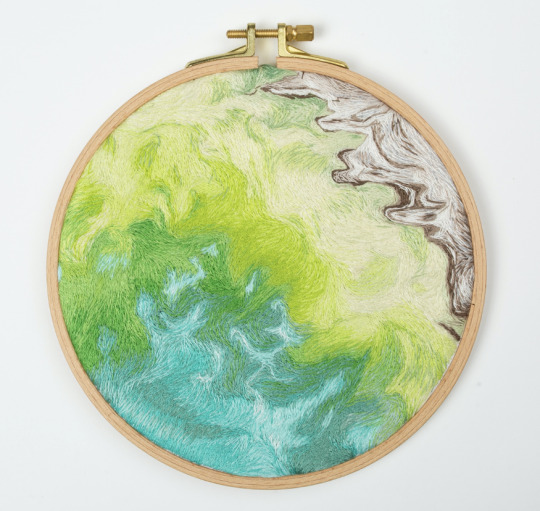
Danielle Currie of Satellite Stitches created a piece inspired by the Caspian Sea, taken by NASA’s ocean color satellites. Credit: Danielle Currie/Satellite Stitches
Danielle Currie is an environmental professional who resides in New Brunswick, Canada. She began embroidering at the beginning of the Covid-19 pandemic as a hobby to take her mind off the stress of the unknown. Danielle’s piece is titled “46.69, 50.43,” named after the coordinates of the area of the northern Caspian Sea captured by LandSat8 in 2019.

An image of the Caspian Sea captured by Landsat 8 in 2019. Credit: NASA
Two Hubble Images of the Pillars of Creation, 1995 and 2015
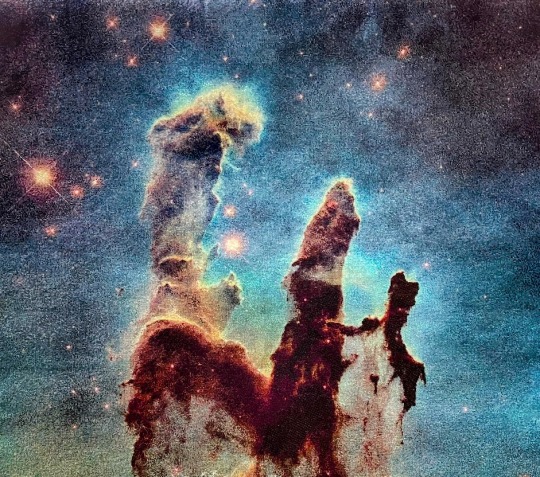
Melissa Cole of Star Stuff Stitching created an embroidery piece based on the Hubble image Pillars of Creation released in 1995. Credit: Melissa Cole, Star Stuff Stitching
Melissa Cole is an award-winning fiber artist from Philadelphia, PA, USA, inspired by the beauty and vastness of the universe. They began creating their own cross stitch patterns at 14, while living with their grandparents in rural Michigan, using colored pencils and graph paper. The Pillars of Creation (Eagle Nebula, M16), released by the Hubble Telescope in 1995 when Melissa was just 11 years old, captured the imagination of a young person in a rural, religious setting, with limited access to science education.
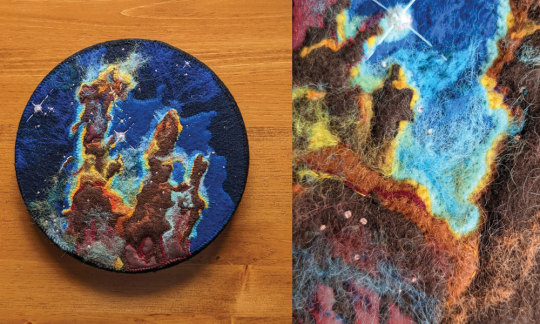
Lauren Wright Vartanian of the shop Neurons and Nebulas created this piece inspired by the Hubble Space Telescope’s 2015 25th anniversary re-capture of the Pillars of Creation. Credit: Lauren Wright Vartanian, Neurons and Nebulas
Lauren Wright Vartanian of Guelph, Ontario Canada considers herself a huge space nerd. She’s a multidisciplinary artist who took up hand sewing after the birth of her daughter. She’s currently working on the illustrations for a science themed alphabet book, made entirely out of textile art. It is being published by Firefly Books and comes out in the fall of 2024. Lauren said she was enamored by the original Pillars image released by Hubble in 1995. When Hubble released a higher resolution capture in 2015, she fell in love even further! This is her tribute to those well-known images.
James Webb Telescope Captures Pillars of Creation
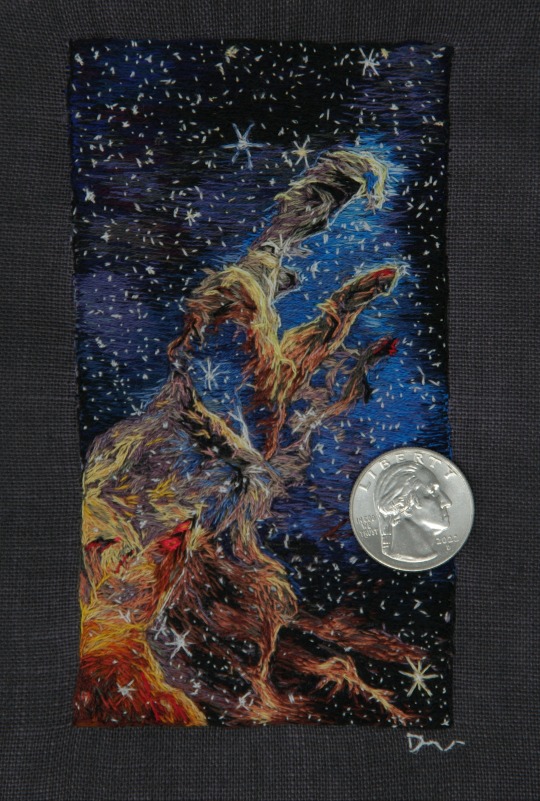
Darci Lenker of Darci Lenker Art, created a rectangular version of Webb’s Pillars of Creation. Credit: Darci Lenker of Darci Lenker Art
Darci Lenker of Norman, Oklahoma started embroidery in college more than 20 years ago, but mainly only used it as an embellishment for her other fiber works. In 2015, she started a daily embroidery project where she planned to do one one-inch circle of embroidery every day for a year. She did a collection of miniature thread painted galaxies and nebulas for Science Museum Oklahoma in 2019. Lenker said she had previously embroidered the Hubble Telescope’s image of Pillars of Creation and was excited to see the new Webb Telescope image of the same thing. Lenker could not wait to stitch the same piece with bolder, more vivid colors.
Milky Way
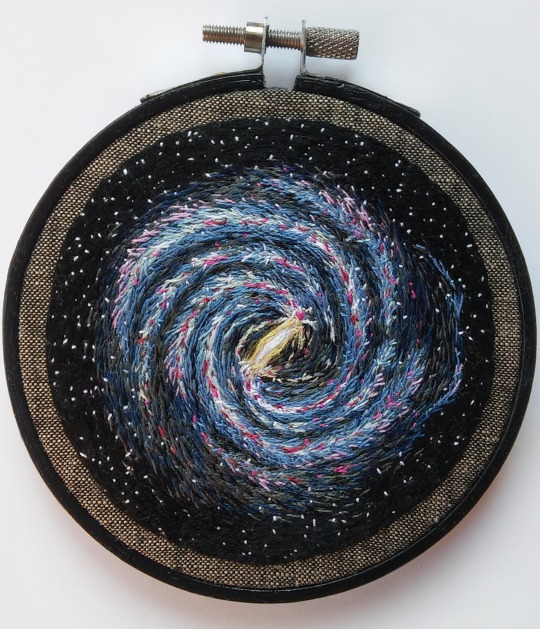
Darci Lenker of Darci Lenker Art was inspired by NASA’s imaging of the Milky Way Galaxy. Credit: Darci Lenker
In this piece, Lenker became inspired by the Milky Way Galaxy, which is organized into spiral arms of giant stars that illuminate interstellar gas and dust. The Sun is in a finger called the Orion Spur.
The Cosmic Microwave Background
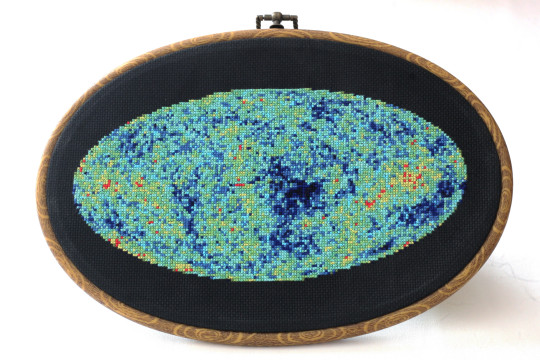
This image shows an embroidery design based on the cosmic microwave background, created by Jessica Campbell, who runs Astrostitches. Inside a tan wooden frame, a colorful oval is stitched onto a black background in shades of blue, green, yellow, and a little bit of red. Credit: Jessica Campbell/ Astrostitches
Jessica Campbell obtained her PhD in astrophysics from the University of Toronto studying interstellar dust and magnetic fields in the Milky Way Galaxy. Jessica promptly taught herself how to cross-stitch in March 2020 and has since enjoyed turning astronomical observations into realistic cross-stitches. Her piece was inspired by the cosmic microwave background, which displays the oldest light in the universe.

The full-sky image of the temperature fluctuations (shown as color differences) in the cosmic microwave background, made from nine years of WMAP observations. These are the seeds of galaxies, from a time when the universe was under 400,000 years old. Credit: NASA/WMAP Science Team
GISSTEMP: NASA’s Yearly Temperature Release
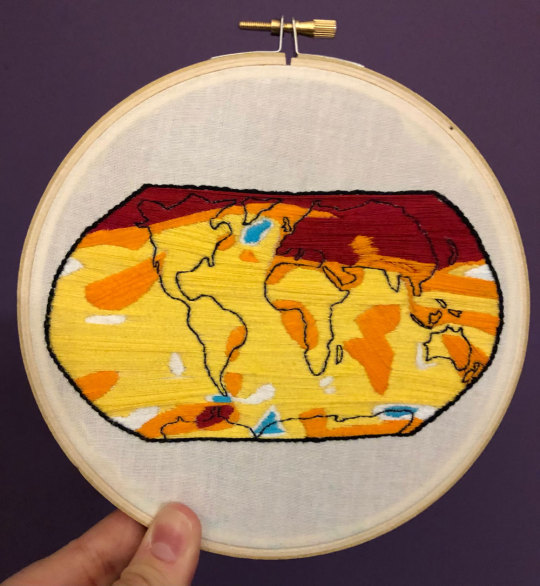
Katy Mersmann, a NASA social media specialist, created this embroidered piece based on NASA’s Goddard Institute for Space Studies (GISS) global annual temperature record. Earth’s average surface temperature in 2020 tied with 2016 as the warmest year on record. Credit: Katy Mersmann, NASA
Katy Mersmann is a social media specialist at NASA’s Goddard Space Flight Center in Greenbelt, Md. She started embroidering when she was in graduate school. Many of her pieces are inspired by her work as a communicator. With climate data in particular, she was inspired by the researchers who are doing the work to understand how the planet is changing. The GISTEMP piece above is based on a data visualization of 2020 global temperature anomalies, still currently tied for the warmest year on record.
In addition to embroidery, NASA continues to inspire art in all forms. Check out other creative takes with Landsat Crafts and the James Webb Space telescope public art gallery.
Make sure to follow us on Tumblr for your regular dose of space!
#NASA#creativity#fiber art#embroidery#art#art challenge#needlework#crafts#handmade#textile art#cross stitch#stitching#inspiration#inspo#Earth#Earth science#Hubble#James Webb Space Telescope#climate change#water#nebula#stars
6K notes
·
View notes
Text






vintage stationary
envelope (1843)
Esther Howland lace lithograph Valentine (mid-1800s)
Studies on Twilight Phenomena after Krakatoa by Eduard Pechuël-Loesche (1888)
origami folk art card (1900)
Philadelphia College of Textiles and Science fabric sample
1K notes
·
View notes
Text







Bhakti Ziek is a well known artist, weaver, and teacher who currently lives and works in Vermont. She creates weavings using Jacquard looms, and helped to establish the graduate program in textile design at the Philadelphia College of Textiles and Science. Bhakti initially learned to weave because she wanted to have a useful skill for living on a commune, her experiences learning backstrap weaving in Guatemala, how she ended up finding an artistic home with Jacquard weaving, and quite a bit more.
A former college professor, she now offers private workshops in her Santa Fe, NM studio.
https://d3zr9vspdnjxi.cloudfront.net/.../4691827-download...
21 notes
·
View notes
Text
Finding a sweet spot between radical and relevant
New Post has been published on https://thedigitalinsider.com/finding-a-sweet-spot-between-radical-and-relevant/
Finding a sweet spot between radical and relevant
While working as a lecturer in MIT’s Department of Architecture, Skylar Tibbits SM ’10 was also building art installations in galleries all over the world. Most of these installations featured complex structures created from algorithmically designed and computationally fabricated parts, building off Tibbits’ graduate work at the Institute.
Late one night in 2011 he was working with his team for hours — painstakingly riveting and bolting together thousands of tiny parts — to install a corridor-spanning work called VoltaDom at MIT for the Institute’s 150th anniversary celebration.
“There was a moment during the assembly when I realized this was the opposite of what I was interested in. We have elegant code for design and fabrication, but we didn’t have elegant code for construction. How can we promote things to build themselves? That is where the research agenda for my lab really came into being,” he says.
Tibbits, now a tenured associate professor of design research, co-directs the Self-Assembly Lab in the Department of Architecture, where he and his collaborators study self-organizing systems, programmable materials, and transformable structures that respond to their environments.
Play video
His research covers a diverse range of projects, including furniture that autonomously assembles from parts dropped into a water tank, rapid 3D printing with molten aluminum, and programmable textiles that sense temperature and automatically adjust to cool the body.
“If you were to ask someone on the street about self-assembly, they probably think of IKEA. But that is not what we mean. I am not the ‘self’ that is going to assemble something. Instead, the parts should build themselves,” he says.
Creative foundations
As a child growing up near Philadelphia, the hands-on Tibbits did like to build things manually. He took a keen interest in art and design, inspired by his aunt and uncle who were both professional artists, and his grandfather, who worked as an architect.
Tibbits decided to study architecture at Philadelphia University (now called Thomas Jefferson University) and chose the institution based on his grandfather’s advice to pick a college that was strong in design.
“At that time, I didn’t really know what that meant,” he recalls, but it was good advice. Being able to think like a designer helped form his career trajectory and continues to fuel the work he and his collaborators do in the Self-Assembly Lab.
While he was studying architecture, the digitization boom was changing many aspects of the field. Initially he and his classmates were drafting by hand, but software and digital fabrication equipment soon overtook traditional methods.
Wanting to get ahead of the curve, Tibbits taught himself to code. He used equipment in a sign shop owned by the father of classmate Jared Laucks (who is now a research scientist and co-director of the Self-Assembly Lab) to digitally fabricate objects before their school had the necessary machines.
Looking to further his education, Tibbits decided to pursue graduate studies at MIT because he wanted to learn computation from full-time computer scientists rather than architects teaching digital tools.
“I wanted to learn a different discipline and really enter a different world. That is what brought me to MIT, and I never left,” he says.
Tibbits earned dual master’s degrees in computer science and design and computation, delving deeper the theory of computation and the question of what it means to compute. He became interested in the challenge of embedding information into our everyday world.
One of his most influential experiences as a graduate student was a series of projects he worked on in the Center for Bits and Atoms that involved building reconfigurable robots.
“I wanted to figure out how to program materials to change shape, change properties, or assemble themselves,” he says.
He was pondering these questions as he graduated from MIT and joined the Institute as a lecturer, teaching studios and labs in the Department of Architecture. Eventually, he decided to become a research scientist so he could run a lab of his own.
“I had some prior experience in architectural practice, but I was really fascinated by what I was doing at MIT. It seemed like there were a million things I wanted to work on, so staying here to teach and do research was the perfect opportunity,” he says.
Launching a lab
As he was forming the Self-Assembly Lab, Tibbits had a chance meeting with someone wearing a Stratasys t-shirt at Flour Bakery and Café, near campus. (Stratasys is a manufacturer of 3D printers.)
A lightbulb went off in his head.
“I asked them, why can’t I print a material that behaves like a robot and just walks off the machine? Why can’t I print robots without adding electronics or motors or wires or mechanisms?” he says.
That idea gave rise to one of his lab’s earliest projects: 4D printing. The process involves using a multimaterial 3D printer to print objects designed to sense, actuate, and transform themselves over time.
To accomplish this, Tibbits and his team link material properties with a certain activation energy. For instance, moisture will transform cellulose, and temperature will activate polymers. The researchers fabricate materials into certain geometries so they can leverage these activation energies to transform the material in predictable and precise ways.
“It is almost like making everything a ‘smart’ material,” he says.
The lab’s initial 4D printing work has evolved to include different materials, such as textiles, and has led the team to invent new printing processes, such as rapid liquid printing and liquid metal printing.
They have used 4D printing in many applications, often working with industry partners. For instance, they collaborated with Airbus to develop thin blades that can fold and curl themselves to control the airflow to an airplane’s engine.
On an even greater scale, the team also embarked on a multiyear project in 2015 with the organization Invena in the Maldives to leverage self-assembly to “grow” small islands and rebuild beaches, which could help protect this archipelago from rising seas.
To do this, they fabricate submersible devices that, based on their geometry and the natural forces of the ocean like wave energy and tides, promote the accumulation of sand in specific areas to become sand bars.
They have now created nine field installations in the Maldives, the largest of which measures approximately 60 square meters. The end goal is to promote the self-organization of sand into protective barriers against sea level rise, rebuild beaches to fight erosion, and eliminate the need to dredge for land reclamation.
They are now working on similar projects in Iceland with J. Jih, associate professor of the practice in architectural design at MIT, looking at mountain erosion and volcanic lava flows, and Tibbits foresees many potential applications for self-assembly in natural environments.
“There are almost an unlimited number of places, and an unlimited number of forces that we could harness to tackle big, important problems, whether it is beach erosion or protecting communities from volcanoes,” he says.
Blending the radical and the relevant
Self-organizing sand bars are a prime example of a project that combines a radical idea with a relevant application, Tibbits says. He strives to find projects that strike such a balance and don’t only push boundaries without solving a real-world problem.
Working with brilliant and passionate researchers in the Self-Assembly Lab helps Tibbits stay inspired and creative as they launch new projects aimed at tackling big problems.
He feels especially passionate about his role as a teacher and mentor. In addition to teaching three or four courses each year, he directs the undergraduate design program at MIT.
Any MIT student can choose to major or minor in design, and the program focuses on many aspects and types of design to give students a broad foundation they can apply in their future careers.
“I am passionate about creating polymath designers at MIT who can apply design to any other discipline, and vice-versa. I think my lab is the ethos of that, where we take creative approaches and apply them to research, and where we apply new principles from different disciplines to create new forms of design,” he says.
Outside the lab and classroom, Tibbits often finds inspiration by spending time on the water. He lives at the beach on the North Shore of Massachusetts and is a surfer, a hobby he had dabbled in during his youth, but which really took hold after he moved to the Bay State for graduate school.
“It is such an amazing sport to keep you in tune with the forces of the ocean. You can’t control the environment, so to ride a wave you have to find a way to harness it,” he says.
#3-D printing#3d#3D printers#3D printing#Advice#aluminum#amazing#anniversary#applications#architecture#Art#artists#atoms#Building#career#Careers#cellulose#Center for Bits and Atoms#challenge#change#code#college#computation#computer#Computer Science#Computer science and technology#construction#courses#curl#Design
0 notes
Text
Philadelphia's Synthetic Dye Legacy: History and Impact
I confess I never thought about how science created most of the colors around me until I chanced upon Philadelphia’s Science History Institute’s Bold: Color from Test Tube to Textile. Here are some of the things I learned from this fascinating exhibit. When William Perkins was an 18-year-old college student in England in 1856, tried to synthesize quinine from coal tar. (At that time, quinine was…
0 notes
Text

Aleksandra Kasuba, 1977. Philadelphia College of Textile and Science, studio space.
0 notes
Text
Herb Magee Named at the 2023 SCB Lifetime Achievement Award Winner
Herb Magee Named 2023 SCB Lifetime Achievement Award Winner
Kansas City, MO – Small College Basketball is extremely excited to announce Herb Magee as the recipient of the 2023 SCB Lifetime Achievement Award. This is the fifth year that the Small College Basketball has awarded the Lifetime Achievement Award. Dr. Jim Poteet, the Chair of the SCB Alumni Association had this to say about this year’s award recipient:
“Herb Magee is a small college basketball icon both as a player and a coach,” mentioned Poteet. “His impact on one college (through several name changes) may never be repeated. It is with great joy the Alumni Association of Small College Basketball presents the 2023 Lifetime Achievement Award to Herb Magee.”
After 54 seasons as the men’s basketball coach at Thomas Jefferson University, Coach Magee retired following the 2021-22 season. Coach Magee guided the Rams through several institution name changes, from Philadelphia College of Textiles & Sciences (1961-99) to Philadelphia University (1999- 2017) to Thomas Jefferson University (2017-22). Coach Magee was a standout player for then Philadelphia Textile. From 1959-1963, Magee scored 2,235 points and averaged a school record 29.1 points per game during the 1961-62 season. He was named All-American in 1962 and 1963 and led the Rams to a 75-17 record. In 1963 Magee led the Rams to the NCAA Tournament quarterfinals.
In 1963, after graduating from Philadelphia College of Textiles & Sciences, Coach Magee was drafted by the Boston Celtics with the 62 nd pick. Coach Magee decided not to join the Celtics and went back to serve as an assistant coach at his alma mater. Coach Herb Magee had this to say about being named the 2023 Lifetime Achievement Award winner:
“I am very honored to accept this award,” stated Magee. “I want to accept the award on behalf of all my assistant coaches and players that I had the privilege to work with in my 55 year coaching career.”
Coach Magee started his career as an assistant coach under Walter “Bucky” Harris, before taking over the program in 1967. On his way to a Hall of Fame career, Coach Magee compiled 1,144 victories. At the end of his career he was the winningest NCAA Division II men’s basketball coach of all time. Coach Magee led his teams to 31 NCAA Tournament appearances, including a national championship in 1970. During the 1970 season, the Rams overcame a 1-2 start to run off 28 consecutive victories on their way to the championship. In the their final 26 victories, the Rams wonby a double-figure margin. The Rams defeated Tennessee State 76-65 in the national championship.
Under Coach Magee’s leadership, the Rams finished with 38 seasons with at least 20 wins and 13 with at least 25 wins. Coach Magee led the Rams to a school record 30 wins during the 1992-93 season. Magee’s teams finished with a winning record for an astonishing 25 consecutive seasons during from 1977-2022. Coach Magee finished with a career record of 1,144-450. Current Thomas Jefferson University men’s basketball coach Jimmy Reilly had this to say about Coach Magee:
“What Coach Magee accomplished will never be duplicated,” stated Reilly. “If you think about what he did at one school, it’s truly amazing. He belongs on the Mount Rushmore of college basketball coaches. I am so lucky to have had a front row seat to see him in action for 15 years.”
Coach Magee has produced 13 All – Americans, 49 1,000 point scorers and three 2,000 point scorers. In 2007, Christian Burns was selected as the Daktronics NCAA Division II Player of the Year. After joining the Central Atlantic Collegiate Conference, Magee led 15 different players to be named to the CACC All – Academic team. In Magee’s final season at the helm, the Rams finished with a 21-6 mark and a CACC South Division title and a semifinal appearance in the CACC Tournament.
Coach Magee was inducted into the Naismith Memorial Basketball Hall of Fame in 2011. He is a member of a number of Hall of Fame’s including the West Catholic High School of Fame, Pennsylvania Sports Hall of Fame in 1979, the Philadelphia University Athletics Hall of Fame in 1984, the Philadelphia Area Small College Basketball Hall of Fame in 2002, Philadelphia Sports Hall of Fame in 2008, and the Middle Atlantic Conference Hall of Fame in 2022. He was named regional Coach of the Year four times, national Coach of the Year twice, and Co-Coach of the Year in the Mideast Collegiate Conference twice.
In 2005, Coach Magee was selected as a Guardian of the Game by the National Association of Basketball Coaches (NABC) under its education core value and was honored at the NCAA Division I Final Four. Coach Magee was also awarded the Lifetime Achievement Award from the Philadelphia Sports Congress. In 2012, the Philadelphia Sports Writers Association chose Coach Magee as its “Living Legend.” The NABC honored Coach Magee in 2020 as the Hillyard Golden Anniversary Award.
In 2022, Coach Magee was the recipient of the NCAA President’s Pat Summitt Award. Coach Magee was given the nickname “The Shot Doctor” after working with numerous NBA players on the art of the jump shot. He worked with Charles Barkley, Jameer Nelson and Evan Turner. Coach Magee also produced a pair of instruction DVDs: “Nothing but Net” and “Nothing But Drills.”
“I feel so fortunate to have had a career that allowed me to coach and work with so many amazing young men including many NBA players,” stated Magee.
Coach Magee will be awarded the SCB Lifetime Achievement Award at the National Awards Show on Saturday April 22nd.
For more information on the SCB Lifetime Achievement Award and Small College Basketball head to smallcollegebasketball.com.
0 notes
Text
GVL / Generously Entangled

Generously Entangled curated by matthew anthony batty November 5 - December 11 Opening Reception: Friday, November 5, 6-9 pm 4 Smith St, Greenville, SC
Tiger Strikes Asteroid Greenville (TSA GVL) is excited to announce their next exhibition, the fifth show in their new West Greenville gallery space. Generously Entangled brings together the work of Codi Maddox, Emmanuel Manu Opoku, Michelle Laxalt, and Jiha Moon. The show is curated and organized by TSA GVL member matthew anthony batty.
In the movement and passing of threads, complex structures can be formed– structures that draw forth ritual, the observable now, and evoke the future. Practices of mindfulness braid together materials of earth and matter, narrative and exchange, nuance and pigment. These practices and materials become embodiments Generously Entangled in image and object. This exhibition explores the intertwining practices of aesthetic hybridity, material culture, and reciprocity through the paintings of Codi Maddox, the assemblages of Emmanuel Manu Opoku, and the ceramic collaboration of Michelle Laxalt & Jiha Moon.
Codi Maddox is an Atlanta-born self-taught artist. Her work focuses on themes of nostalgia, and Black cultural markers. Codi Maddox begins her work seeking to find a sense of self and reconnect to her identity. She looks to art as a way to express the complexity of her life thus far in all its nuances. Joy, sadness, identity, and experiences.
Emmanuel Manu Opoku was born and raised in Kumasi, Ghana. He holds M.F.A. in Sculpture from the University of Florida in Gainesville and B.F.A. in Painting from the Kwame Nkrumah University of Science and Technology in Kumasi, Ghana. He is a recipient of the James J. Rizzi Studio Award, Harold Garde Studio Art Award, College of the Art Dean's Award, and the Outstanding International Student Award. Emmanuel has participated in several exhibitions in Ghana and the United States. He currently lives in Gainesville, Fl.
Jiha Moon (b. 1973) is from DaeGu, Korea, and lives and works in Atlanta, GA. She received her MFA from the University of Iowa, Iowa City. Her works have been acquired by Asia Society, New York, NY, High Museum of Art, Atlanta, GA, The Mint Museum of Art, Charlotte, NC, Smithsonian Institute, Hirshhorn Museum and Sculpture Garden, Washington, DC, Weatherspoon Museum of Art, Greensboro, NC and The Virginia Museum of Fine Arts, Richmond, VA. She has had solo exhibitions at the Museum of Contemporary Art of Georgia, GA, Taubman Museum, Roanoke, VA, the Mint Museum of Art, Charlotte, NC, The Cheekwood Museum of Art, Nashville, TN and Rhodes College, Clough-Hanson Gallery, Memphis, TN and James Gallery of CUNY Graduate Center, New York, NY. She has been included in group shows at Kemper Museum, Kansas City, MI, the Fabric Workshop and Museum, Philadelphia, PA, the Atlanta Contemporary Art Center, Atlanta, GA, Asia Society, New York, NY, The Drawing Center, New York, NY, White Columns, New York, NY, Smith College Museum of Art, Northampton, MA, and the Weatherspoon Museum of Art, Greensboro, NC. She is a recipient of the Joan Mitchell Foundation's painter and sculptor’s award for 2011. Her mid-career survey exhibition, “Double Welcome: Most everyone’s mad here” organized by Halsey Institute of Contemporary Art and Taubman Museum has toured more than 10 museum venues around the country until 2018.
Michelle Laxalt is a multidisciplinary artist currently based in Atlanta, Georgia. She earned a BFA from the University of Nevada, Reno, and an MFA as a Welch Fellow from Georgia State University in Atlanta. Through ceramics, textiles, and other sculptural media, Laxalt addresses the vulnerability we as humans share with animals and other living beings. Laxalt has shown nationally and internationally in solo and group exhibitions. Notable venues include the Uşak Archeology Museum in Uşak, Turkey; the National Center for Contemporary Arts in Minsk, Belarus; Whitespace Gallery in Atlanta, GA; MINT Gallery in Atlanta, GA; and the Zuckerman Museum of Art in Kennesaw, GA. She has given artist talks at Gallery 72 and MINT Gallery in Atlanta and has participated on artist panels at the Holland Project Gallery (Nevada), Georgia Tech (Atlanta), and Auburn University (Alabama). She has completed artist residencies at the Vermont Studio Center (2016) and the Hambidge Center in North Georgia (2019). Laxalt was a 2019 MINT Leap Year Fellow and concluded her fellowship with her solo exhibition Husk. Upcoming group exhibitions in which Laxalt will exhibit include The Skull Show at Sheppard Contemporary (Reno, Nevada) and All In at the Holland Project Gallery (Reno, Nevada).






























photos by Jessica Swank
0 notes
Photo





“Ain’t I An Artist?” Empowering Yourself As An Artist: Embracing The Value Of Women In The Arts
The “Art of the Quilt” show at MAAG is glorious and the exhibition is up until April 25. It’s involving all types of quilters, from emerging to professional, from traditional to contemporary. But we’ve been particularly struck, especially for International Women’s Day, by the number of participants in this show who have conquered their own doubts about being artists. In short, they have empowered each other.
So, this Sunday at 3 pm, at 11 West Mt. Airy Ave., we want to talk about it. And we’re confident you’ll want to be in the mix. This conversation will address art forms associated with women’s work and their place in fine art. We’ll pose the question “What puts the art in quilt?” “Does function equal fine art?”
Join our distinguished panel of textile, quilt, and fiber artists — Sarah Bond, Diana Trout, Carol Loeffler, Elena DiLapi, and Heather Ojiie as we discuss the role that women play in enriching visual culture. Read on for bios on our panel.
$10 at the door.
Panelists and Bios
Sarah Bond is a quilt artist and a teacher. Her art revolves mostly around traditional quiltmaking. She likes functional work; she likes making things that people can use and live with. She likes to play with traditional quilt designs and experiment with color and variation. Her teaching style focuses on making even the most complicated patterns accessible and achievable for her students. She is a resident artist at Mt. Airy Art Garage and pursues her quilt evangelism through classes and the world-famous Quiltapalooza!
Elena DiLapi —Tailler Puertorriqueno, and Former Director, UPenn Women’s Center for 23 years.
Carole Loeffler—Artist and Professor in the Visual and Performing Arts Department at Arcadia University. Carole is a native of New Jersey and received her B.F.A. from Mason Gross School of the Arts at Rutgers University and received her M.F.A. from University of South Florida in Tampa. Previously, she taught and directed the Foundations program at Southern Illinois University Carbondale in the School of Art and Design. She is currently teaching Sculpture, Senior Seminar and coordinating the Foundations program at Arcadia University in the Performing Arts Department in Glenside, PA.
While residing in the Midwest, Carole had numerous solo and group exhibitions in New York, St. Louis, Chicago, Cleveland, North Carolina, Indiana and Florida. Since relocating to the East Coast, she has had regional exhibitions in Connecticut, Delaware, Maryland and Philadelphia. Her work is driven by intuitive process and play with various materials. The precipitating work takes many forms including sculpture, painting and immersive installations.
Diana Trout —Diana’s professional life is weighted equally between her twin passions for teaching and creating. Her stitched mixed media textiles, watercolor and bookarts have been exhibited nationally. Her artwork and articles have appeared in national magazines. Quilting is a hobby that offers a rich sandbox to play with color shape and texture. Trout’s book, Journal Spilling, Mixed Media Techniques for Free Expression is used by artists, art journalers and teachers. Trout trained in Painting and Printmaking at Pa. Academy of the Fine Arts. She is a life time learner and explorer. You can reach Diana at her blog, http://dianatrout.typepad.com/
Heather Ujiie — I grew up in a loft in Greenwich Village, New York City, in a family of artist educators, and my artistic career has been informed by a lively bohemian childhood. I currently live in Bucks County, PA and serve as an adjunct professor, teaching across disciplines in art & design at Moore College of Art & Design and Philadelphia University. I am both an artist and a designer, and my professional design experience includes designing for dance, theatre, and textile print design in New York City. My textile installation work has been exhibited in The Hunterdon Museum of Art, The Racine Art Museum, and at the prestigious Wind Challenge Award Exhibition at the Samuel S. Fleisher Art Memorial Museum. My work has also been included in exhibitions in the Cleveland Museum of Art, The State Museum of Pennsylvania, and The Delaware Center for Contemporary Art, and The Philadelphia International Airport. I also currently show my textile print design work at Flavor paper in New York, a high-end textile wall-covering company for modern interiors.
I hold a Bachelor of Science Degree in Visual Art from the State University of New Paltz, NY, an Art- Education Degree from Brooklyn College, and an Associates Degree in Textile Surface Design, from The Fashion Institute of Technology in New York. I have over 15 years of experience as a textile designer, for the home furnishing market in New York City. My textile installation work has been exhibited in The Hunterdon Museum of Art, The Racine Art Museum, and at the prestigious Wind Challenge Award Exhibition at the Samuel S. Fleisher Art Memorial Museum. My work has also been included in exhibitions in the Cleveland Museum of Art, The State Museum of Pennsylvania, and The Delaware Center for Contemporary Art, and The Philadelphia International Airport. My printed textile designs have had numerous clients including Flavor Paper, and The White House private residences for President George W. Bush and Laura Bush, Washington D.C. I also currently have a blossoming career as a nationally known artist.
We want to thank Valley Green Bank for their sponsorship to this event.
0 notes
Photo

Philadelphia College of Textiles and Science Archive
French Print 1895
0 notes
Photo

*workshop alert* Color in Cloth: The Weaves You Want and Why with Cameron Taylor-Brown in May 2017. Description: #Weave structures mix #color in very different ways. How do we determine what #weaves are "right" for what we have in mind? View #weavings from #inspiration #museum #textile collections of the #LosAngeles County Museum of Art, the Textile Museum in #Washington, D.C., and the Cooper-Hewitt in New York, supplemented by #images and woven samples from Cameron's own stash. Explore a wide range of weaving across different #cultures and time periods and closely examine how weave choices dramatically affect our perception of color in #cloth. Make samples that use a variety of weave structures to mix colors for specific #visual effects, and create an original #design with your new weave and color vocabulary. Level and Prerequisites: Advanced Beginning - students must have #warped a #loom previously and be able to read basic #weaving #drafts. Dates: Friday, Saturday, and Sunday, May 12, 13, and 14: 9:30 A.M.-4:30 P.M. Materials Fee: A $25 materials fee is payable to the instructor Tuition: $360 for WGM members / $396 for non-members Equipment information: Students are welcome to use a WGM Schacht loom for weaving their fabric in our classroom space, or they may bring their own loom from home. Instructor: Cameron Taylor-Brown has immersed herself in the worlds of fiber, education and commerce since the 1970s. She studied fiber art at the University of #California, Berkeley with artist Ed Rossbach and textile design at the #Philadelphia College of Textiles and Science. She worked in New York City as a stylist of #upholstery and home furnishing fabrics, taught textile design at the #Philadelphia College of Textiles and Science and worked as an #exhibition #curator. Since 1985, Taylor-Brown has lived in Los Angeles where she maintains a studio and is active in several arts organizations. She was a founding board member of the Textile Group of Los Angeles and a past President of California Fibers and Designing Weavers. >>>Register in link in profile! #weavingmn http://ift.tt/2lpVGt6
1 note
·
View note
Link
Artists: Sara Magenheimer, Maggie Lee, Alima Lee, E. Jane, Nikita Gale, Whitney Claflin
Venue: Shoot the Lobster, New York
Exhibition Title: Dear Delia
Date: February 16 – March 29, 2020
Click here to view slideshow
Full gallery of images, press release and link available after the jump.
Images:
Videos:
Alima Lee, Meditation on Madness, 07:41
Sara Magenheimer, SAFE, 2020, HD video, 04:47
E. Jane, mood 08 (giving no fucks), 2015-2017 video, color, sound, 01:21
E. Jane, mood 06 (practicing), 2015-2017, video, color, sound, 00:34
Images courtesy of the artists and Shoot the Lobster, New York
Press Release:
Delia Derbyshire was a musician and composer known for her work with the BBC Radiophonic Workshop during the 1960s, including her arrangement of the iconic theme music to the ongoing British science-fiction television series Doctor Who. Though she remained uncredited for the work until Doctor Who’s 50th anniversary special (12 years posthumously), Derbyshire continued to produce historical work in electronic sound. A true pioneer, Derbyshire faced countless obstacles but forged ahead, becoming what many refer to as “the unsung heroine of British electronic music.”
Dear Delia is a letter to the legend. Six artists hailing from various practices and backgrounds — Whitney Claflin, Nikita Gale, E. Jane, Alima Lee, Maggie Lee, and Sara Magenheimer — coalesce in the gallery to create a multimedia homage to Derbyshire in an installation of works on paper, collage and video.
Whitney Claflin (b. Providence, RI) received an MFA from Yale University School of art in 2009 and a BFA from Rhode Island School of Design in 2004. Claflin is a visual artist who creates amorphous paintings resulting from a conceptual practice wherein she studies the narrative of mark making across various media. She lives and works in Brooklyn, NY. Select exhibitions include By All Means, You Can Have Two Halloweens, Drei, Cologne, Germany (2020); Crows, Real Fine Arts, Brooklyn, NY (2014); Exteriorized Bliss, The Green Gallery, Milwaukee, WI (2015); Painting: Now and Forever, Part III, Greene Naftali, New York, NY (2018); Zombie Formalism, Mitchell Algus, New York NY (2016).
Nikita Gale (b. Anchorage, AK) received an MFA from the University of California, Los Angeles in 2016 and a BA from Yale University (2006). Gale is a visual artist working in sculpture, film, text, and sound. Her practice is structured by a study of objects, and the way they are imbued with social and political histories. She lives and works in Los Angeles, CA. Select exhibitions include ‘AUDIENCING,’ PS1, New York, NY (2020); HOT WORLD, Reyes|Finn, Detroit, MI (2019); ‘Fall Apart,’ Martos Gallery, New York, NY (2019); ‘Extended Play,’ 56 Henry, New York, NY (2018); ‘MADE IN L.A.,’ Hammer Museum, Los Angeles, CA (2018); Keynote Drift, Atlanta Contemporary Art Center, Atlanta, GA (2018); DESCENT, Common Wealth & Council, Los Angeles, CA (2018); and RIFF FATIGUE, Artist Curated Projects, Los Angeles, CA (2017).
E. Jane (b. Bethesda, MD) received an MFA from the University of Pennsylvania in 2016 and a BA from Marymount Manhattan College in 2012. E. Jane is a Black woman, conceptual artist, sound designer and musician. Their work is a critical inquiry surrounding softness, safety, Alice Walker’s womanism, futurity, cyberspace and how subjugated bodies navigate media/the media. Their interdisciplinary practice incorporates text, digital images, video, performance, sound- based, sculpture, textile and installation works. They live and work in Brooklyn, NY. Select exhibitions include HOTLINE, SPACE, Portland, ME (2019); I Was Raised On The Internet, Museum Of Contemporary Art Chicago, Chicago, IL (2018), Torrent Tea: Queer Space and Photographic Futures, Newspace Center for Photography, Portland, OR (2017); Wandering / WILDLING: Blackness on the Internet, IMT Gallery, London, UK (2016). E. Jane is currently in residence at The Studio Museum in Harlem, New York, NY.
Alima Lee (b. New York, NY) is a filmmaker, designer, artist, curator, and DJ. Her work explores themes of identity and intersectionality. She is Co-Founder and Art Director of Akashik Records music label, and Co-Host of a monthly show, Rave Reparations, on NTS. She lives and works in Los Angeles, CA. Select film work presentations and exhibitions include EBSPLOITATION, Martos Gallery, New York, NY (2019); Screen: Black Radical Imagination, MOCA, Los Angeles, CA (2018); The Worst Witch, Shoot The Lobster, Los Angeles, CA (2018); The Smithsonian African American Film Festival, Smithsonian African American Museum, Washington, DC (2018); Portals 1, Gavin Brown’s Enterprise, New York, NY (2018); Black Radical Imagination, ICA Boston, MA (2018).
Maggie Lee (b. 1987) Received a BFA from the Pratt Institute in Brooklyn, NY. Lee is a multimedia artist working in collage, film, and installation – mining content from her personal biography, as well as subculture and cult classics. She lives and works in Brooklyn, NY. Select exhibitions include Cracki’s Birthday, Édouard Montassut, Paris, France (2019); Moon Represents My Heart: Music, Memory and Belongings, MOCA, New York, NY (2019); Reset, Kai Matsumiya, New York, NY (2019); Music Videos, Arcadia Missa, London, UK (2018); Maggie Lee, Lomex, New York, NY (2017); Gigi’s Underground, 356 Mission, Los Angeles, CA (2016); Fufu’s Dream House, Real Fine Arts, New York, NY (2016); Billboard on Bowery, Robert Blumenthal Gallery, New York, NY (2017); Speak, Lokal, Kunstalle Zürich, Switzerland (2017); Homo Mundus Minor, T293, Rome, Italy (2017); Mirror Cells, Whitney Museum of American Art, New York, NY (2016).
Sara Magenheimer (b. Philadelphia, PA) received an MFA from Bard College in 2013 and a BFA from The School of the Museum of Fine Arts, Boston in 2004. Magenheimer is a multimedia artist whose practice spans video, sound, performance, sculpture, collage and installation, creating surprising juxtapositions with language, graphic symbols, sound, and imagery. In her video work, visual and verbal signs mutate to open up new channels of understanding. She lives and works in New York, NY. Select exhibitions include Sara Magenheimer: NOON, New Museum, New York, NY (2018); I Collect Neglected Venoms, The Kitchen, New York, NY (2017); I am a Scientist, V1 Gallery, Copenhagen, Denmark (2018); Frame Structures, Magenta Plains, New York, NY (2018); Freuds Mouth, Cooper Cole Gallery, Toronto, Canada (2016); Chatham Square, Foxy Production, New York, NY (2016); CCCC (Ceramics Club Cash and Carry), White Columns, New York, NY (2015).
Link: “Dear Delia” at Shoot the Lobster
from Contemporary Art Daily https://bit.ly/2SLBQLS
0 notes
Text
Phd/Ms in textile in usa
InstitutionDegrees OfferedContact Information Auburn UniversityMS and PhD inDr. Pamela Ulrich Consumer and Design SciencesConsumer & Design [email protected] Ball State UniversityM.A.Dr. Diana Saiki Family and Consumer [email protected] Cornell UniversityMA and PhD in Apparel DesignDr. Margaret Frey Fiber Science and Apparel DesignMS and PhD in Fiber [email protected] MPS in Design (in development) Colorado State UniversityM.S. in Design and MerchandisingDr. Jennifer Paff Ogle, Karen Hyllegard, Nancy J. Miller Design and [email protected] Fontbonne UniversityMSAngela Dowell Human Environmental SciencesHuman Environmental [email protected] Concentration in Apparel Studies Framingham State UniversityGraduate Certificate in Merchandising–onlineDr. Irene Foster Fashion Design and [email protected] Consumer Sciences Department Illinois State UniversityM.S.Dr. Yoon Jin Ma Family and Consumer [email protected] Iowa State UniversityM.S.Dr. Ann Marie Fiore Apparel, Educational Studies, and Hospitality ManagementNon-Thesis [email protected] Ph.D. (on campus) Ph.D. (distance) Kansas State University*Ph.D., M.S.Dr. Sherry Haar Apparel, Textiles and Interior Design GPIDEA [email protected] Lim CollegeMBA-Fashion Management and EntrepreneurshipParul Mucciarone Center for Graduate StudiesMPS- Fashion Merchandising & Retail [email protected] MPS- Fashion Marketing North Carolina State UniversityMS in Textiles (Thesis option)Dr. Yingjiao Xu Textiles and Apparel, Technology and ManagementMaster of Textiles (non-thesis option)[email protected] Dr. William Oxenham Ph.D. in Textile Technology [email protected] North Dakota State UniversityM.S. in MerchandisingDr. Connie Jadrny Distance and Continuing EducationMerchandising Graduate [email protected] M.Ed. in Family and Consumer Sciences Education Northern Illinois UniversityMS in Family and Consumer SciencesDr. Betty Montgomery, Hyun-Mee Joung School of Family, Consumer and Nutrition SciencesSpecialization in Apparel [email protected] Ohio UniversityM.S.Dr. Ann Paulins,Dr. Mijeong Noh Patton CollegeHuman and Consumer [email protected] Apparel, Textiles, MerchandisingMajor: Apparel, Textiles, and [email protected] Oklahoma State UniversityPh.D.Dr. Semra Peksoz, Cosette Armstrong, Mary Ruppert-Stroescu Design, Housing, and [email protected] Oregon State UniversityPH.D., M.S., M.A.Dr. Hsiou-Lien Chen School of Design and Human [email protected] San Francisco State UniversityM.S.Dr. Nancy Rabolt Consumer and Family Studies/DieteticsApparel Design & [email protected] South Dakota State UniversityM.S.Dr. Jane Hegland Consumer SciencesHuman Sciences-Merchandising [email protected] Graduate Certificate- Merchandising Texas State UniversityM.S.Jiyun Kang, Ph.D. , School of Family and Consumer StudiesMerchandising and Consumer [email protected] Texas Tech UniversityM.S., Hospitality & Retail ManagementDr. Deborah Fowler, M.S. Hospitality and Retail ManagementPh.D., Hospitality Management w/Emphasis in Retail [email protected] Dr. Betty Stout, Ph.D. [email protected] Texas Tech UniversityOnline Graduate CertificateDr. Katie Leigh Meeks Fibers and Biopolymers [email protected] University of DelawareM.S. in Fashion and Apparel StudiesBelinda T. Orzada, Ph.D. Fashion and Apparel StudiesGraduate Certificate in Socially Responsiblew and Sustainable Apparel BusinessGraduate Program Director [email protected] University of GeorgiaM.S., Textiles, Merchandising & InteriorsDr. Yoo-Kyoung Seock, Soyoung Kim Textiles, Merchandising & InteriorsPh.D., Textile [email protected] Ph.D., Emphasis in International Merchandising University of KentuckyM.S.Dr. Kimberly Miller-Spillman, RayeCarol Cavender, Elizabeth Easter, Scarlett Wesley Merchandising, Apparel & [email protected] University of MissouriPh.D.Dr. Pamela Norum Textile and Apparel ManagementM.S.137 Stanley Hall University of MinnesotaPh.D.Dr. Marilyn Delong Design, Housing and Apparel [email protected] M.A. University of North Carolina-GreensboroPh.D.Dr. Nancy Hodges Consumer, Apparel, and Retail [email protected] University of North TexasM.S. in MerchandisingDr. Lisa Kennon College of Merchandising, Hospitality & TourismGraduate Certificate in [email protected] MBA/MS in Merchandising University of Rhode IslandM.S.Dr. Linda Welters Textiles, Fashion, Merchandising, & [email protected] Washington State UniversityM.S.Dr. Linda Bradley, Ting Chi Apparel, Merchandising, Design, and [email protected] University of Alabama, Dr. Virginia Wimberley Tel: (205) 348-6176 DEPARTMENT OF CLOTHING, TEXTILES, AND INTERIOR DESIGN Lousiana State University Philadelphia University University of ArkansasMaster’s Degree in Human Environmental Sciences with a concentration in Apparel Merchandising and Product DevelopmentKathy Smith at [email protected] or 479-575-2577 Ohio State University Central Michigan Univeristy University of Wyoming Dr. Bruce Cameron , [email protected] University of California West Virginia University Cindy Beacham, [email protected] Eastern Michigan University New Mexico State University University of Tennessee University of Akron Middle Tennessee State University University of Tennessee-KnoxvilleTextile Science
from USA Admission – Study in USA , F1 Visa, Opt https://usaadmission.com/ms-and-phd-in-textile/
0 notes
Text
AIR Cycle 10 Artist Spotlight: Erin Palumbo
AIR Cycle 10 Artist Spotlight: Erin Palumbo By Christine Sloan Stoddard Erin Palumbo, a 2018 graduate of the Rhode Island School of Design (RISD), came to the Textile Arts Center after her mother’s urging. Donna had taken dyeing classes at TAC and thought the Artists in Residency program might be a good fit for her. Mom turned out to be right. “AIR definitely helped me realize that there’s no one way to have [an artistic] practice. Everybody has their own way that they do things, their own way that their mind formulates their ideas,” says Erin during our FaceTime interview, since she now lives in Philadelphia as a graduate student at Thomas Jefferson University. “The residency really helped me develop and know that my practice is legitimate.” She adds that the community at TAC contributed to feelings of validation: “I was always surrounded by other people, so I could interact and get feedback. You don’t always get that when you rent studio space and you’re alone.” As a recent graduate, Erin could easily compare the AIR program to her college experience. “There was a lot less pressure [than at RISD],” she says. “The only pressure was the pressure I put on myself. It took me a while to accept that this was supposed to be fun.” Of course, that’s not to say that TAC’s AIR program was a free-for-all. “I like how the program offered guidance and some structure,” says Erin. “It was kind of like school in that sense, but without deadlines, pressure, and stress. It helps you to not get lost, but you can really enjoy your process.” Erin’s process began when she was young. Since her mother is a textile designer, she explains that she has been around textiles her whole life. Yet she didn’t immediately think she would follow her mother’s path. “We always try not to be like our parents, but we are exactly like them,” she laughs. Mid-way through college, Erin took courses in textiles. Toward the beginning of her senior year, she felt she had found her calling. At that point, she was a printmaking major with a practice rooted in drawing. She started to see how she could translate her drawings into textiles. During the TAC AIR program, Erin worked part-time at interior textile design studios to expand her technical knowledge. “TAC helped me facilitate my personal ideas while I worked at the studios,” she says. For the AIR program’s group exhibition, Lost/Found, in September, Erin created CUTE SOFT, an immersive experience. She created a room, almost like a booth, with printed fabric walls akin to wallpaper. A dress with a double-sided print (front and back) hung on the outside of the room. Inside the room was a book containing five prints. Astroturf lined the floor. The aesthetic is as “cute” as the title implies: bright, colorful, and youthful. . “Over the past two years, I’ve been doing a lot of research on post-internet theory,” says Erin. “I chose to focus on two concepts [for this piece]: escapism and consumption/instant gratification.” . She adds, “It is a cute, soft space. The idea is when you’re reading the book, you’re physically inside of it. The purpose of the garment is to give the idea that you can wear this world that I created. Then there’s the idea of being able to sell it, own it, keep it—mass consumption.” . Erin explains the relevance of “cuteness” to CUTE SOFT as this: “Cuteness is this idea that you can make something more appealing. If it’s appealing, it can sell. More people want it. I use [cuteness] in my work as a way of being able to approach heavy subject matter in a way that’s approachable.” . Now that she’s in grad school, Erin is making a collection and learning relevant science and technology along the way. . “I’m not saying good-bye to all of this research, but I feel like I can now begin to explore it in different ways,” she says. . She credits TAC AIR as the place to explore and complete that research—for now.
0 notes
Text
Frederick B. Dent
Frederick Baily Dent, 97, of Spartanburg, SC, died Tuesday, December 10, 2019, at Spartanburg Medical Center. Born August 17, 1922, in Cape May, NJ and raised in Greenwich, CT, he was the son of the late Magruder Dent and Edith Baily Dent. He was the husband of 53 years to the late Mildred “Millie” Harrison Dent and a member of The Episcopal Church of the Advent in Spartanburg. At the age of 3, Fred’s family moved from Ardmore, PA to Greenwich, CT, along with the textile sales operation of his father’s company, Joshua L. Baily & Company. Founded in 1876 by Fred Dent’s maternal great-grandfather, the company was a factoring and textile sales agency where he was first employed in 1946. A graduate of Greenwich Country Day School and St. Paul’s School in Concord, NH, Mr. Dent earned a BA Degree at Yale University where he was a liberal arts major with an emphasis on political institutions and also played varsity football. He also received honorary degrees from Presbyterian College, Charleston Southern University, Philadelphia College of Textiles and Science, the University of South Carolina, and Yale University. He was an avid sailor as a youth and joined the Naval Reserve Officer Training Corps at Yale and was a U. S. Navy veteran of World War II. Mr. Dent was a resident of Spartanburg since 1947 where he served as president of Mayfair Mills – a textile manufacturing company with six plants, five in South Carolina and one in Georgia. Throughout his career, he also served as president of the American Textile Manufacturers Institute and South Carolina Textile Manufacturers Association. He was trustee of Yale University, the Institute of Textile Technology in Charlottesville, VA, Brevard Music Center, and the Arts Partnership of Greater Spartanburg, as well as Chairman of the Board of Mayfair Mills, Inc. His former directorships include International Paper Company, COMSAT Corporation, General Electric, Mutual Life Insurance of New York, Scott Paper Company, Armco Steel, S. C. Johnson & Company, and SCN Corporation. He also provided leadership as chairman of the Spartanburg Area Chamber of Commerce and Spartanburg Planning and Development Commission and as a member of the Business Council. He was among the founders of Spartanburg Day School where he was a life-trustee emeritus. As a respected business leader, he served on President Richard M. Nixon’s Commission on All-Volunteer Armed Force in 1969, and was subsequently appointed Secretary of Commerce by the President, serving from February 2, 1973-March 26, 1975 and also served as President Gerald R. Ford’s Special Trade Representative with the rank of Ambassador from March 26, 1975-January 20, 1977. Mr. Dent was inducted into the South Carolina Business Hall of Fame in 1994. Survivors include his children, Frederick B. Dent Jr. and wife Susan Kenney Dent of Spartanburg, SC, Mildred Dent Stuart of Lexington, KY, Pauline Dent Ketchum and husband Thomas Bray Ketchum of Greenwich, CT, Diana Dent McGraw of Spartanburg, SC, and Magruder Harrison Dent and wife Sara Greer Dent of Chevy Chase, MD; grandchildren, Frederick Baily Dent III, Paul Harrington Dent (Grace), Catherine Dent Patterson (Jim), James Harrison Stuart (Katherine), John Alexander Stuart (Alana), Dylan Dent Ketchum (Debbie), Diana Dent Ketchum, Benjamin Dent Ketchum (Tory), Bray Ketchum Peel (Kevin), Frederick Dent Ketchum, Greer Jewett Dent, Millicent Carrington Dent, Margaret Holeman Dent, and Magruder Harrison Dent Jr.; and 13 great-grandchildren. In addition to his parent’s and wife, he was predeceased by his siblings, Magruder Dent Jr. of Charlottesville, VA, Edith Dent Moore of Fairfield, CT, and Diana Gwynn Dent of Greenwich, CT. Funeral services will be conducted at 2:00 PM Saturday, January 11, 2020, at the Episcopal Church of the Advent, by The Rev. J. Edward Morris and The Rev. Clay Turner. A reception will follow from 2:45-4:00 PM in the Parish and Community Life Center. A private committal will be held in Greenlawn Memorial Gardens. In lieu of flowers, memorials may be made to The Episcopal Church of the Advent Foundation, 141 Advent St., Spartanburg, SC 29302; Mobile Meals Service, PO Box 461, Spartanburg, SC 29304; or Spartanburg Day School, 1701 Skylyn Drive, Spartanburg, SC 29307. Floyd’s Greenlawn Chapel from The JF Floyd Mortuary via Spartanburg Funeral
0 notes